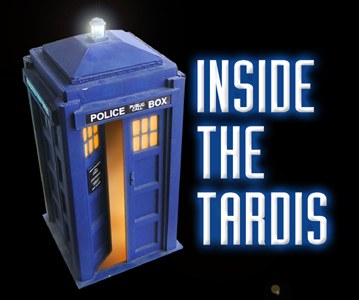


I'm a massochist.
I must be.
But I'm also a little obsessed with Doctor Who. Among other Science Fiction universes. During the late 1980s I watched every episode from Tom Baker's first episode "Robot", to Sylvester McCoy's last episode, "Survival", and when it was aired, I also watched the TV movie starring Paul McGann. I've also listened to a bunch of the Big Finish audio productions. Since then I've seen episodes starring each Doctor from first to last. I've been amassing a small collection of VHS episodes from all Doctors.
About a decade ago or so, angst over the ending of a particular Doctor Who episode led me to write a short-story to reconcile certain problems I had with that episode. A couple of years ago I produced it as my first Doctor Who photo story starring various 12" action figures, and sets and props I created myself. The story, "Redemption", dealt with the Doctor's fateful decision during the stories "Earthshock" and "Time-Flight". I won't go into that here, you can see for yourself my reasons behind doing that story.
One of the story arcs I remembered most was the Key to Time series, which recently became available on DVD. The interesting thing about that show was that it was an entire season based around the story arc of the Doctor being summoned by the White Guardian to find the six segments of the Key to Time. The first episode, "The Ribos Operation" was quite good, and the episode "The Pirate Planet" is distinguished by being the only episode credted to Douglas Adams as writer, though he did help write others, including "City of Death" and "Shada" which, sadly, due to a BBC strike, never got fully produced. It has been available in partial form on VHS with Tom Baker narrating the unfilmed gaps, and it recently became avilable as an audio production from Big Finish.
But at the end of the Key to Time series, the Doctor is asked for the Key by the Guardian, but the Doctor suspects something is up. Sure enough, he was approached by the Black Guardian in disguise. When the Guardian says he's going to keep the key for a while, rather than immediately redisburse it, the Doctor refuses to give the Black Guardian the powerful Key to Time, and instead redistributes it back throughout the universe. He knew the White Guardian would never keep Princess Astra frozen in time as a component to the key. He would have used the key, rebalanced the universe, and put everything back where it belonged.
This never sat well with me. It seemed a huge loose end. The White Guardian expends all this effort to get the Doctor to find the six pieces of the Key to Time, only to lose it again, and ... nothing. No complaint, no repercussions.
And besides, what was the White Guardian doing asking the Doctor for help anyway? The Doctor is notorious for not following rules, and for doing his own thing. How could he possibly be trusted for such an important task?
After thinking about it for a long time, it occurred to me that perhaps there was more to the story. If you wanted such an important task done by such a random, untrustworthy character, wouldn't you want to test his character first? Sure you would.
So that's it. The first time was a test. And the Doctor passed with flying colors. He not only retrieved all six pieces to the Key to Time, but when faced with handing it over to an evil force, refused, and sent it back to its original hiding places.
In my story, the Doctor has proven his trustworthiness, and is summoned again, to do the real job.
A few years ago, I found a transparent plastic star puzzle, and I thought that it would make a nice Key to Time. The original Key was a cube, of course, and it made sense to me that the real thing would also be a symmetrical geometric shape. I searched eBay for quite some time before finding a clear plastic Star Puzzle. I actually found two. One was a bit old and scratched, the other in perfect condition. I figured I'd use the scratched one for long shots, and use the perfect one for close-ups.
It is implied in this prologue that the White Guardian has done something violent to the Doctor. What he did, in fact, was basically upload his knowledge of the importance of the Key to the Doctor's brain. Which can be somewhat disorienting at the best of times.
For my title screen and for certain other shots in the story (including the shot of the White Guardian showing the Doctor the Second Key) I modeled the Star Puzzle in Lightwave as closely as I could and animated it rotating. The result is pretty decent if I do say so myself:

For this story I used animated GIF files to highlight certain things such as the key rotating. Doing this required a little forethought and planning. To animate the whole frame as a GIF file I would lose a lot of color information as animated GIF files only use 256 colors while JPEG images use millions. However, an animated GIF file can be transparent around the edges, so I could animate the Second Key to overlay over another graphic.
However, HTML won't allow you to just place one graphic over another... almost. What it does allow you to do is place a GIF file in a table. And it will allow your table to have a background graphic. This was the solution. By using a background image in a table and then an animated GIF file over that, I could have certain parts of the frame animate. I've never done this before this story, and I have to say the result is excellent.
I use it in later episodes to show the Locator flashing.
The White Guardian:
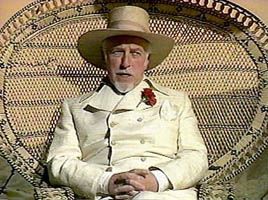 |
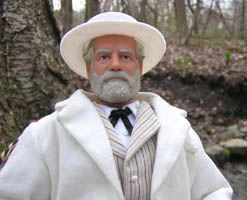 |
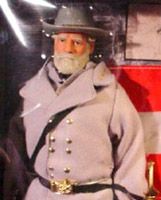 |
|
The White Guardian
played by Cyril Luckham |
The White Guardian
played by General Robert E. Lee |
Hasbro's General Robert E. Lee - in package
|
In the original Key to Time series, the White Guardian first appears as an elderly human with white goatee, ivory suit with sun hat, drinking a cocktail while sitting in a wicker high-back chair. My General Robert E. Lee GI Joe, used most often as my Adventure Team Commander, seemed to resemble that guy enough that I wanted to use him to reprise the White Guardian's role.
As for his outfit, here, the White Guardian is wearing the Barbie Rhett Butler outfit. This Barbie cost somewhere in the range of $70.00, but I found this one on eBay for a hell of a lot less. It fits the bill well.
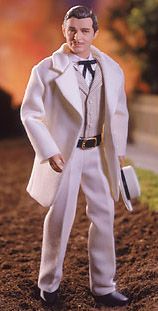
Rhett Butler - Barbie figure
Steven York, a fellow Joe collector (and novelist) sent me a small plastic Martini, and I knew I had to use that as well. Also, at a yard sale a couple of years ago, I found a 1:6 scale wicker high-back chair. It's a bit smaller than the one used in the TV show, but it works.
 |
 |
|
Mini Martini
|
Mini Wicker Chair
|
The Doctor again is the Buzz Aldrin GI Joe used in "Redemption." I like his face, and according to what he said in that episode, he's on his last regeneration (though I highly suspect he was lying.)
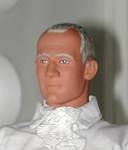 |
|
Buzz Aldrin GI Joe
|
However, in this episode, the Doctor is wearing a different coat and scarf. The coat was hand-made by Vikki Godwin, who makes some excellent 1:6 scale Doctor Who outfits. She sells them, so if you like, you can order one of her fine pieces. They're worth the money. You'll note that the coat he wore in "Redemption" is hanging on his coat-rack.
The scarf came from Pier One. They make a placemat with multi-colored stripes which I gave to a friend, Jeanette Chamberlain, who sewed them into several Doctor Who length scarves for me, including frills at the ends. She's quite a seamstress, specializing in period dresses and Jean doll clothing which rivals anything I've ever seen. I think she should sell her one-of-a-kind outfits on eBay and make a small mint.
In Redemption, the Doctor leaves Tegan on Earth leaving us with the impression he's about to go to E-Space to drop Adric off back on his home planet there. If you recall, in the episode "Warrior's Gate", Romana II left the Doctor to help a race of people overcome oppression in E-Space. K-9, the Doctor's robotic dog decides to remain with his Mistress. As my story starts, it's obvious the Doctor has visited Romana and K-9, offered to bring them back to N-Space, (normal space) but they refuse. He is affronted.
Then the TARDIS shuts itself down, and all becomes dark. This is a familiar scene if you recall the first few minutes of "The Ribos Operation", the first segment of the Key to Time.
If you pay attention to things like that, you'll see that the original shot of the Doctor with the TARDIS door open looks a lot like my reproduction of the similar scene in which the Guardian calls upon the Doctor for the second time.
 |
 |
|
This is a frame from "The Ribos Operation".
The Doctor's TARDIS shuts down, and the doors open revealing a bright
light from outside.
|
My version of the same scene. In my story, the Doctor
is once again summoned by the White Guardian.
|
I reused the 1:6 scale TARDIS I built for "Redemption" including the interior. However, I completely rebuilt the coat-rack for this story. The last one was copper wire on a wooden dowel, and I wanted it to be more sturdy. The epoxy didn't stick well to the wood. This time I used a metal rod for the center, and intended to solder it together for a good solid construction, but the solder wouldn't take to the metal rod. I ended up epoxy-gluing the copper wire to the metal rod, and that held very well. Still, the result is not much better, and I have to consider it a failed experiment rather than time wasted.
In "Redemption" the TARDIS door never opened, so it was just cut into the foam-core walls, and was non-functional. In this episode it is required that the door open so the Guardian can shine his light into the TARDIS mimicking the opening scene of "The Ribos Operation". It doesn't hinge, it just comes out of its socket, and I lean it up against the wall to make it look open.
The rondelles on the door are different, though only because I left the styrofoam bowl pieces for those holes at home. I improvised by using different styrofoam bowls I found at work where I shot the interiors. If anything, these worked better.
As for the exterior, I really like my TARDIS. I built it from foam core. I have a page on how it was built. However, I noticed recently that I made the wrong door open. The door that traditionally opens on the TV show is the right-hand door, not the one with the phone cover. Oh well... let that be my quirk, then.
The first step to any story like this is a storyboard. In order to ensure I shoot the story with a flow and a style that befits the script. If you have a story in mind and just shoot random pictures, you may not end up with the result you like. Still, sometimes I resort to that, but it sure helps to have a guide like this storyboard nearby. The idea is not to shoot the storyboard, but to use it as a guide. Sometimes reality prevents you from shooting the storyboard exactly. Don't sweat it. Let the moment take you.
Segment One, of course, where the Doctor meets his first Companion in
a while...